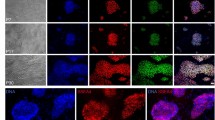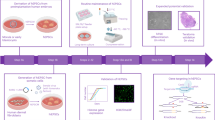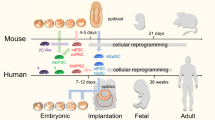Abstract
Human embryonic stem cells (hESCs) need feeder cells for their maintenance in an undifferentiated state. In conventional culture systems, mouse embryonic fibroblasts (MEFs) serve as feeder cells to maintain hESCs. However, the use of MEFs elevates the risk of transmitting mouse pathogens and thus limits the potential of hESCs in cell replacement therapy. Consequently, the use of human feeder cells would be an important step forward in this in vitro technology. To address this issue, we used fibroblast-like cells differentiated from the Miz-hES6 hESC line (Diff (Miz-hES6)) as feeder cells to support the in vitro growth of three hESC lines. Immunofluorescence microscopy and reverse transcription-PCR assessing the expression of undifferentiated hESC markers revealed all three hESC lines were maintained in an undifferentiated state. In vitro proliferation proceeded as efficiently as when the hESCs were cultured on MEFS. Moreover, karyotype analysis revealed the chromosomal normality of the hESC lines and the Diff (Miz-hES6) feeders themselves after even 50 passages. Furthermore, the hESC lines maintained their pluripotency since they remained capable of forming embryoid bodies (EBs) in vitro. Thus, hESC-derived fibroblast-like cells successfully support in vitro hESC propagation.
Similar content being viewed by others
Article PDF
Author information
Authors and Affiliations
Rights and permissions
This is an Open Access article distributed under the terms of the Creative Commons Attribution Non-Commercial License (http://creativecommons.org/licenses/by-nc/3.0/) which permits unrestricted non-commercial use, distribution, and reproduction in any medium, provided the original work is properly cited.
About this article
Cite this article
Yoo, S., Yoon, B., Kim, J. et al. Efficient culture system for human embryonic stem cells using autologous human embryonic stem cell-derived feeder cells. Exp Mol Med 37, 399–407 (2005). https://doi.org/10.1038/emm.2005.50
Published:
Issue date:
DOI: https://doi.org/10.1038/emm.2005.50
Keywords
This article is cited by
-
Fibroblasts derived from human embryonic stem cells direct development and repair of 3D human skin equivalents
Stem Cell Research & Therapy (2011)
-
Differentiation of embryonic stem cells into fibroblast-like cells in three-dimensional type I collagen gel cultures
In Vitro Cellular & Developmental Biology - Animal (2011)
-
A feeder-free culture using autogeneic conditioned medium for undifferentiated growth of human embryonic stem cells: Comparative expression profiles of mRNAs, microRNAs and proteins among different feeders and conditioned media
BMC Cell Biology (2010)
-
Derivation of Man-1 and Man-2 research grade human embryonic stem cell lines
In Vitro Cellular & Developmental Biology - Animal (2010)
-
Deconstructing human embryonic stem cell cultures: niche regulation of self-renewal and pluripotency
Journal of Molecular Medicine (2008)



